

Measurement of the Oxygen Potential of Non-Ferrous Slags with an Ex-Situ Electrochemical Device N. Moelans 1 , B. Coletti 1 , J. Plessers 2 , M. Straetemans 2 , B. Blanpain 1 , P. Wollants 1 1 Department of Metallurgy and Materials Engineering, Katholieke Universiteit Leuven, Kasteelpark Arenberg 44, B-3001 Leuven, Belgium 2 Heraeus Electro-Nite Int. N.V. , Centrum Zuid 1105, B-3530 Houthalen, Belgium
Contents • Introduction • Experimental procedure – Measurement – Materials – Calculations • Results and discussion • Conclusion
Introduction : importance of p O2 • Affects reactivity with • Metal • Matte • Lining of reactor • Available devices • In-situ: Celox TM , Celox-SLAC TM • Ex-situ: Ferro-Actis TM , RAPIDOX TM
Experimental procedure: measurement • Electrochemical cell V e - Ni / NiO // ZrO 2 (MgO) // slag / Ir • Reference electrode : Ni ZrO 2 Ir – Ni/NiO (1050 0 C-1400 0 C) O 2- – Mo/MoO (1400 0 C -1650 0 C) • Bath electrode : – Iridium conductor partially covered by silica • Solid electrolyte : NiO M/MO – MgO stabilized ZrO 2
Experimental procedure: measurement • Formulas – Nernst’s law : p slag ( ) RT O EMF ln 2 = nF p ref ( ) O 2 – For a Ni/NiO reference : 20.171* EMF 24,420 − ( ) log p 8.88 = + O T 2 p O2 (bar), EMF (mV), T (K)
Experimental procedure: measurement • RAPIDOX Sensor
Experimental procedure: measurement • Atmosphere • Nitrogen (99.8 %) (N 2 ) • Nitrogen + 5% hydrogen (N 2 +5%H 2 ) • Nitrogen + thin layer (30-40 g) carbon black fine cokes (N 2 +C) • Rotating crucible + eccentrically placed sensor • Limitation of polarisation • Homogenisation of melt
Experimental procedure: measurement 1400 Melt Measurement Sensor 1200 out Measurement Temperature (°C) 1000 Sensor in Gas closed 800 600 Heating Cool down 400 200 Gas in 0 0 50 100 150 200 250 300 350 400 450 Time (min)
Experimental procedure: materials Pb Cu Ni Zn Fe Slag 1 2.5 0.2 <0.1 5.9 25.0 Lead blast furnace slag Slag 2 0,74 0.30 <0.02 5.1 21.5 Cleaned lead blast furnace slag Slag 3 <0.1 0.10 <0.1 0.7 0.3 Reduced lead blast furnace slag Slag 4 29.9 2.7 1.7 3.6 10.1 Lead-copper smelter slag Slag 5 36.0 24.0 5.6 1.3 3.0 Copper convertor slag
Experimental procedure: calculations • Calculations using FactSage (thermodynamic software) • Equilibrium with metal (100 g slag/ 1 g metal) – Slags 1, 2 and 3: Pb rich metallic phase – Slags 4 and 5: Cu rich metallic phase • Slag components = oxides • p O2 of the system = result
Results • Slag 1 N2+5%H2, 1200 °C (1) N2+5%H2, 1100 °C -8.2 -8.4 -8.6 -8.8 log(pO 2 ) -9 -9.2 -9.4 -9.6 -9.8 -10 0 1 2 3 4 5 6 time (min)
Results • Slag 1 N2+C, 1200 °C (1) N2+C, 1200 °C (2) N2+C, 1100 °C 0 -2 -4 log(pO2) -6 -8 -10 -12 -14 0 1 2 3 4 5 6 7 8 9 10 time (min)
Results • Slag 4 with C (1) with C (2) without C with C (3) log (p O2 ) Time (min)
Results Slag Measured log(p O2 ) Calculated log(p O2 )) N 2 (+ 5% H 2 ) N 2 + C 1100 °C 1200 °C 1300 °C 1100 °C 1200 °C 1100 °C 1200 °C 1 -9.5 -8.4 -10.8 -9.0 -10.5 -9.6 2 -7.7 -6.6 -10.7 -10.3 3 -10.6 -11.3 -10.4 4 -6.5 -6.4 -8.1 -7.1 5 -3.7 -6.8
Conclusions • Range : 10 -3 -10 -12 bar • p O2 < 10 -6 : carbon layer • Ideal measurement temperature : • Depends on slag system • Corresponds to tapping temperature • Problems • Dissolution of silica protection and corrosion of sensor • Polarisation • Homogenisation of the melt
Recommend
More recommend